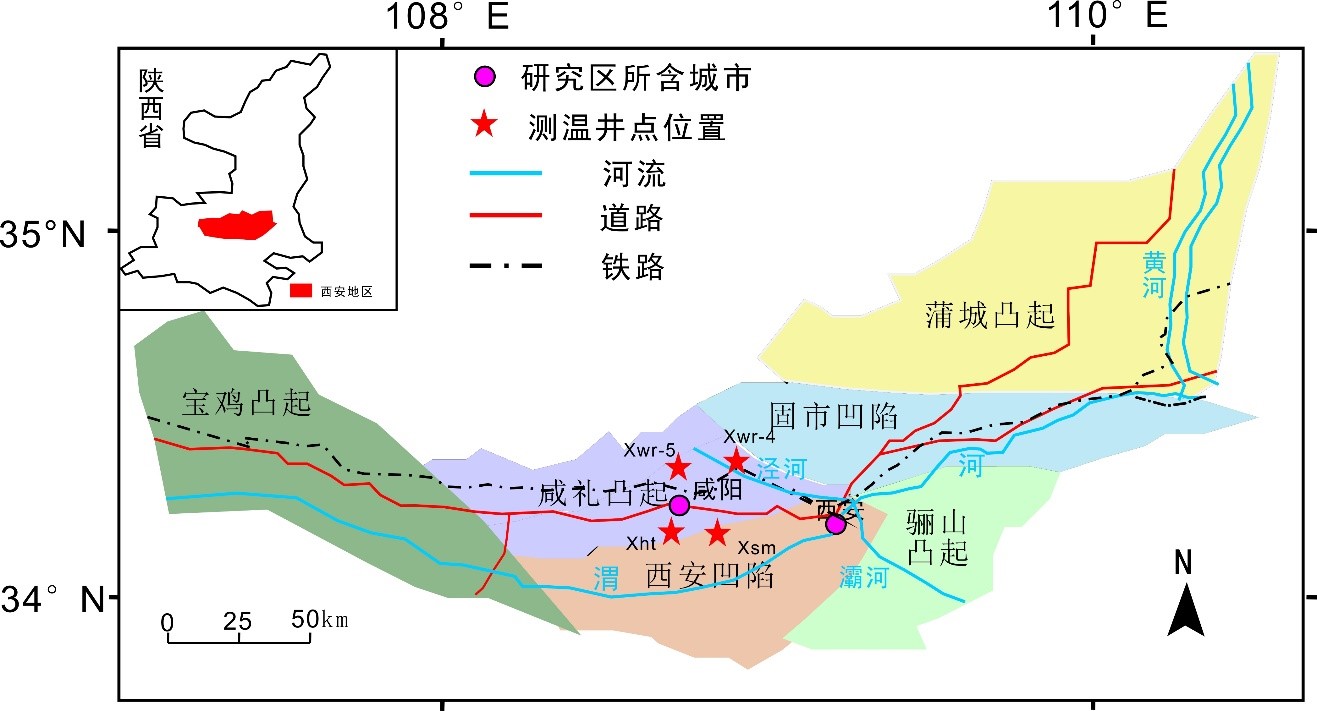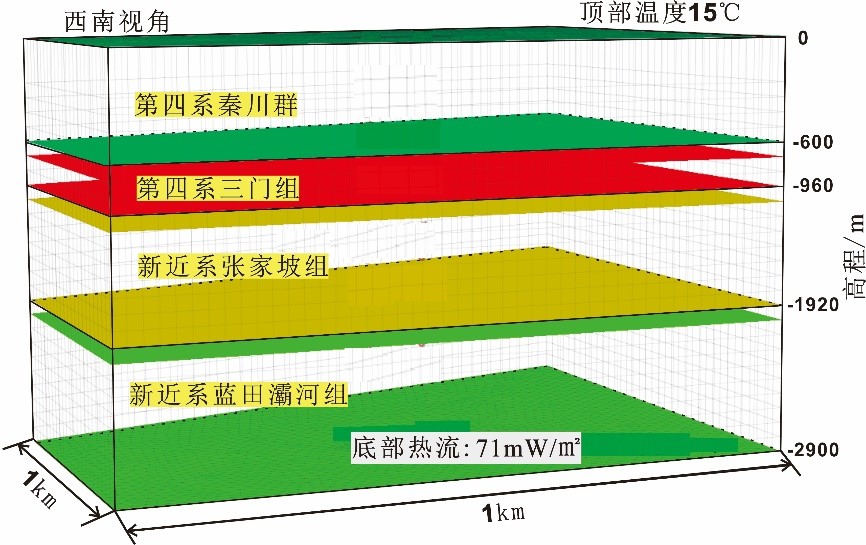博文
唐晓音,程璐瑶等——西安地区中深层套管式地埋管换热性能数值模拟
||
西安地区中深层套管式地埋管换热性能数值模拟
唐晓音1 程璐瑶2 许 威2 柯婷婷2 董 英3 拓佳胜2, 4
(1. 中国地质科学院地质力学研究所 北京 100081;2. 西安交通大学,人居环境与建筑工程学院 西安 710049;3. 中国地质调查局西安地质调查中心 西安 710054;4. 信息产业部电子综合勘察研究院 西安 710054)
摘 要 本文建立了符合西安地区地热地质的三维地质模型,基于FEFLOW软件模拟了入口流量、入口温度、换热井深度以及出水管管材导热系数4种参数对套管式地埋管换热器换热性能的影响,以换热量为换热性能衡量标准,探究如何合理设置参数来提高换热效率。结果表明:1)增加入口流量会导致出口端温升降低、换热量增大,西安地区入口流量设置在15~25 m3/h最为适宜;2)增加换热井深度会使得出口端温升和换热量呈指数增长,井深对换热量的影响主要取决于换热段所处地层温度及换热时长,岩石导热系数贡献较小;3)针对西安地区,入口温度对换热量的影响最为明显,出水管管材导热系数和换热井深度次之,入口流量影响效应相对较弱。本研究对西安地区中深层地埋管换热系统设计施工和地热能勘探开发具有指导和参考意义。
关键词 西安地区 套管式地埋管 换热影响因素 数值模拟
Numerical study on factors that influence the heat transfer performance of mid-deep coaxial casing heat exchanger in the Xi’an area
Abstract:In order to find optimal parameters to promote the heat transfer rate for the coaxial casing heat exchanger in the Xi’an area, we established a three-dimensional geological model in this study, and then simulated the influence of four parameters, that is the inlet water flow rate, inlet water temperature, heat exchange borehole depth, and the outlet inner pipe thermal conductivity, on the heat transfer performance. The results show that: 1) Increasing the inlet water flow rate will lead to an increase in heat exchange, but a decrease in outlet water temperature. It is most appropriate to set the inlet flow rate at 15 m3/h ~25 m3/h in Xi’an area; 2) Increasing the depth of the heat exchange borehole will cause exponential growth in outlet water temperature and the heat transfer. The influence of borehole depth on the heat transfer mainly depends on the formation temperature and heat transfer duration rather than the thermal conductivity; 3) For the Xi’an area, the inlet water temperature has the most obvious impact on the heat transfer, followed by the thermal conductivity of the outlet pipe, the depth of the heat exchange borehole and the inlet water flow rate. This study is not only significant for the design and construction of the buried pipe heat exchange system, but also for the exploration and development of geothermal energy in Xi’an area.
Keywords Xi’an area, Coaxial casing heat exchanger, Effect factors for heat transfer, Numerical modeling
能源危机的不断加深和环境污染的日益凸显迫使人类将目光更多地投向新能源(Huang, 2012)。近些年,太阳能、风能和核能取得了大力发展,而更为稳定、安全和可持续的地热能发展相对落后。相对于风能和太阳能,地热能更具稳定性和普遍性,可全天候利用;相对于核能,地热能更清洁、安全。广泛利用地热能可以填补风能和太阳能受制于天气变化所留下的空档,从而使包括地热能、风能和太阳能在内的清洁能源在国家能源结构中发挥更大作用,切实推动我国低碳经济发展。作为一种可再生能源,地热能正受到国内外前所未有的高度重视(Edenhofer et al., 2011;汪集旸, 2011)。关中地区地热资源丰富,特别是西安地区,地热资源的开发利用历史悠久。地热资源的开发利用取得了良好的经济、社会和环境效益。但由于欠合理的开发利用,西安地区地面沉降、热污染等问题日益突出(马致远等, 2011;Luo et al., 2017;王昆等, 2018)。
为保证西安地区地热资源的可持续、高效利用,中深层地埋管换热系统近年来在该地区得到一定推广。该系统具有地域适应性广、运行效率高、占地面积小、使用年限长等优点(赵军等, 2007)。然而,该技术当前发展现状是工程实践先于理论研究,缺乏科学理论支撑和技术标准指导,诸多设计问题尚需探讨,比如运行参数不合理导致换热效率偏低等(官燕玲等, 2016; 穆根胥等, 2016)。
目前,针对西安地区中深层地埋管换热系统参数设计对换热效率影响的研究尚处于起步阶段,因此迫切需要选择一种成本低且高效的模拟途径对系统运行效果进行预测和筛选。计算机数值模拟便是一种相对成熟的分析工具,可对地埋管换热系统不同储层热物性参数、管材性质、换热井深度及入口温度、流量下的运行过程进行水热耦合模拟,以便评估系统换热效率对不同参数的响应(Dijkshoorn et al., 2013;Le Lous et al., 2015)。
本文在前人对该区域地质地热研究成果基础上,结合岩石热物性特征及钻井测温资料,建立西安地区的三维地质模型。借鉴国内外众多学者利用数值模拟开展的地埋管换热系统可行性分析及参数优化试验(Dijkshoorn et al., 2013;孔彦龙等, 2017;Liu et al., 2019),采用FEFLLOW软件,对套管式地埋管换热系统进行了数值模拟。以换热量为衡量标准,针对入口流量、入口温度、换热井深度、出水管管材导热系数4种参数对其换热性能影响程度进行了探讨。研究了西安地区中深层地埋管的换热过程与影响因素,结果可为研究区换热钻孔优化设计及综合换热量评价提供有力支撑,对指导工程实践具有重要理论意义和应用价值。

图1 关中盆地地质单元图(据柯婷婷等, 2019修改)
Fig. 1 Schematic geological map of the Guanzhong Basin (modified from Ke et al., 2019) 
图2 数值模拟西安地区三维地质模型
Fig. 2 3D geological model of Xi'an area for numerical simulation
https://blog.sciencenet.cn/blog-400480-1295830.html
上一篇:周慧,黄理力等——塔里木盆地北部跃南断裂带的形成演化
下一篇:钟建华,李阳等——一种新的构造缝洞体系——褶溶体